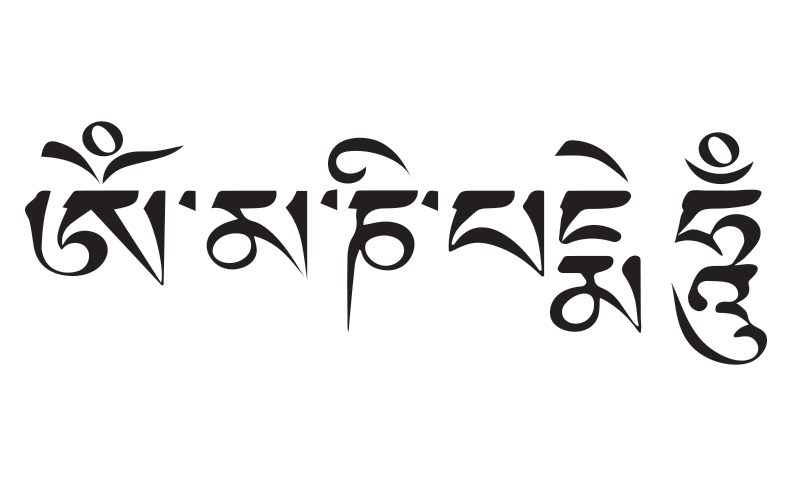
Mantras and Affirmations
Om Mani Padme Hum is the above sanscript phrase, a well-loved Buddhist mantra commonly translated as, “The jewel is in the lotus.”
Yoga Wisdom: Mantras and Affirmations, What You Speak You Become. In 1994, the alternative medicine specialist Masuru Emoto (1943-2014) opened a research center in Japan to study the response of water to different stimuli. Emoto put water in glass jars and subjected it to different types of music, words and images, before letting it freeze at 25 degrees below zero. Then with a microscope, he photographed the crystallized molecules of the water.
This experiment yielded some remarkable discoveries, notably that the samples frozen in accompaniment with the words “love” and ‘thank you” were composed of geometrically perfect crystals. In addition, Emoto decided to test the effect of will and intention on frozen samples of contaminated water. When exposed to a group of children meditating with the intention of gratitude, these deformed and deconstructed water molecules were transformed into crystals that were geometric and harmonious.
Each mantra has its own
unique sound, frequency and intention.
This explanation of Emoto’s research can provide clarity about the chanting of mantras in conjunction with some practices of yoga and the impact on human consciousness. Keep in mind that the human body, as well as the earth, consists of 70 percent water. Also, be open to the possibility that your words, thoughts and intentions have an impact in changing your body and your environment, and vice versa.
A mantra is a sacred phrase, word or syllable that is recited to support you during meditation. Meaning “tool of thought” in Sanskrit, it can be chanted or repeated as many times as needed. It is common for yoga instructors to guide your attention towards your breath to silence the mind. However, not everyone has the same disposition to easily become still and focused solely by directing attention to breath. So this is when mantras can help you achieve not only a serene mind but also an altered state of being, according to the mantra you chant. Each mantra has its own unique sound, frequency and intention; when you chant a mantra repeatedly, you begin to vibrate within its frequency.
 For anyone who finds that Sanskrit sounds do not resonate as a way to enhance the practice of yoga or meditation, I propose using affirmations instead. Affirmations can be in your own language, which makes them more familiar to your logical mind. An affirmation is something that you say or think. Just like mantras, affirmations, when repeated, have a direct effect on your nervous system and also alter the energy that you hold. With your body composed of 70 percent water, the impact is harmonious.
For anyone who finds that Sanskrit sounds do not resonate as a way to enhance the practice of yoga or meditation, I propose using affirmations instead. Affirmations can be in your own language, which makes them more familiar to your logical mind. An affirmation is something that you say or think. Just like mantras, affirmations, when repeated, have a direct effect on your nervous system and also alter the energy that you hold. With your body composed of 70 percent water, the impact is harmonious.
The affirmation I use in my personal practice is: “I choose love.” The mantra I like to use is: “Om Namah Shivaya.”
Cover Story – Costa Rica is the Happiest Country in the World… Why?
Costa Rican Army Abolished: One more reason for happiness?
Feature Article – Living longer in Costat Rica Blue Zone
Costa Rica Yoga and Wellness Retreats
Yogapedia – Vrksasana: Tree Pose
Natural Medicine – CBD Oil: Nature’s Miracle Cure?
Mindfulness: Natural High: Benefits of Nature
Psychological Well Being – Counseling Help in Costa Rica
Eat Well: Costa Rica Superfoods – Nutrient Dense Food
Costa Rica Medical Tourism
Costa Rica Dental Tourism: Veneers – Reason to Smile
Ecotourism in Costa Rica: Sustainable Tourism
Ecotourism Pioneer: Rafael Gallo – Ríos Tropicales
The Osa Peninsula
Ecotourist Road Trip: Sarapiquí
Ecolodges in Costa Rica
Caminos de Osa: Tourism that is helping Costa Ricans
CST Being Green Matters to Diamante Eco-Adventure Park
Grow Sustainably, Build & Live Sustainably in Costa Rica
Behind the Image: Photography as Ecotourism
Building Green and Prove it in Costa Rica
Costa Rica Sustainable Development: Ever Greener
Costa Rica’s indigenous Communities and Indigenous Tribes
